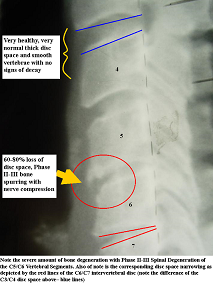Skating proficiency starts literally where your skates meet the road. The way you stack your skeleton between your helmet and wheels determines not only how skillfully and efficiently you can skate, but also how comfortably. If you are...
- just getting started with skating, review Know Your Stances to make sure you’re not developing any bad habits that might lead to future problems.
- getting backaches trying to develop an aerodynamic tuck, read my Back Pain advice in When Skating is a Pain.
- not stretching as part of your fitness routine, incorporate some poses from the Yoga section of my Off-Skate Training program.
- prone to chronic or intermittent back pain as I am, consider seeing a chiropractor for a spinal evaluation--and continue reading.
A Spinal Fitness Program
My active lifestyle keeps me fit and slows down many aging processes. But at 61, my skeleton seems to be aging faster than the rest of me! I’m sometimes haunted by the aftereffects of an old low back injury from weight lifting and the yearly tumbles of snow skiing. After ignoring my neck pain for months on end, a switch to better medical insurance prompted me to return to chiropractic care before whatever was causing my pain in the neck got any worse.
Because I love learning about health and sports performance solutions (and because I live with a skeptic), I did a lot of reading to understand the claims and benefits of chiropractic care. My own interest goes beyond pain relief and general health to the fitness aspects that will keep me skating, skiing and backpacking as I age. Fortunately, my own chiropractor, Dr. Jacob Lhyne has been very thorough and patient in answering my weekly barrage of questions.
After months of research and undergoing my own vertebral “physical therapy,” I’m convinced that by focusing on a deeper aspect of spinal alignment beyond simply maintaining a proper skating stance, I'm advancing my fitness lifestyle to a new level. I believe that regular spinal adjustments will keep my skeleton tuned for the many adventures ahead.
Whether you feel curious or skeptical about this, I invite you to read a short summary below of key points I have paraphrased from Dr. Lhyne’s highly informative Back-to-Health web site (with his approval).
Vertebra are your spinal cord’s helmet
A healthy body is a self-maintaining and self-healing organism. Your immune system is constantly defending against sickness and disease—as long as there is no interference with the normal nerve transmission between brain cells and tissue cells. The spinal column is intended to protect the spinal cord from its origin at the brain stem to where the nerves branch out from it.
An adult spine is composed of 24 moveable bones called vertebrae. Each vertebra is shaped like a ring. The rings are stacked one on top of another forming a vertical tunnel. The delicate spinal cord—slightly thicker than a pencil—is suspended from the brain and extends down through the tunnel of vertebral rings. 31 pairs of smaller nerves branch out from the spinal cord through openings between the vertebrae. Each nerve controls the organs, sensations and much more in a specific area of the body.
 Troubles arise when the spine doesn't fully heal after a fall or other injury. A subtle misalignment may go undetected for years, causing additional damage. Chiropractors refer to the misalignment of one or more vertebra as a subluxation. When they're misaligned or when bone spurs close down the pathway as they have in my own cervical spine (click image for larger view), the inflammation and irritation at the subluxation alters normal nerve function to that area and possibly beyond. This interference with critical transmissions between brain and the rest of the body can have a drastic affect on health.
Troubles arise when the spine doesn't fully heal after a fall or other injury. A subtle misalignment may go undetected for years, causing additional damage. Chiropractors refer to the misalignment of one or more vertebra as a subluxation. When they're misaligned or when bone spurs close down the pathway as they have in my own cervical spine (click image for larger view), the inflammation and irritation at the subluxation alters normal nerve function to that area and possibly beyond. This interference with critical transmissions between brain and the rest of the body can have a drastic affect on health.
Sometimes the misaligned vertebrae may correct themselves, but most subluxations need outside assistance for correction. Chiropractors have the tools to determine exactly how a vertebra is rotated or tilted, and the training to adjust it back into position. The motion of a targeted adjustment also helps to decrease the inflammation and restore mobility and nerve function that may be blocked by a bone spur. While my bone spurs are never going to go away, each adjustment improves my mobility on a small scale and flushes healing circulation into the compressed disc. See How Chiropractic Works for more details.
I encourage every fitness-oriented skater to investigate chiropractic care for maintaining spinal health to keep you rolling for years.
Update 7/13/13: Based on what I've read in Wikepedia after discussing how I feel with Dr. Lhyne, I have reason to believe I am heading toward lumbar spinal stenosis (LSS) for my senior years.